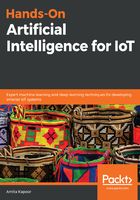
上QQ阅读APP看书,第一时间看更新
IoT verticals
A vertical market is a market in which vendors offer goods and services specific to an industry, trade, profession, or other groups of customers with specialized needs. IoT enables the possibility of many such verticals, and some of the top IoT verticals are as follows:
- Smart building: Buildings with IoT technologies can help in not only reducing the consumption of resources but also improving the satisfaction of the humans living or working in them. The buildings have smart sensors that not only monitor resource consumption but can also proactively detect residents' needs. Data is collected via these smart devices and sensors to remotely monitor a building, energy, security, landscaping, HVAC, lighting, and so on. The data is then used to predict actions, which can be automated according to events and hence efficiency can be optimized, saving time, resources, and cost.
- Smart agriculture: IoT can enable local and commercial farming to be more environmentally friendly, cost-effective, and production efficient. Sensors placed through the farm can help in automating the process of irrigation. It's predicted that smart agricultural practices will enable a manifold increase in productivity, and hence food resources.
- Smart city: A smart city can be a city with smart parking, a smart mass transit system, and so on. A smart city has the capability to address traffic, public safety, energy management, and more for both its government and citizens. By using advanced IoT technologies, it can optimize the usage of the city infrastructure and quality of life for its citizens.
- Connected healthcare: IoT enables critical business and patient monitoring decisions to be made remotely and in real time. Individuals carry medical sensors to monitor body parameters such as heartbeat, body temperature, glucose level, and so on. The wearable sensors, such as accelerometers and gyroscopes, can be used to monitor a person's daily activity.
We'll be covering some of them as a case study in this book. The content of this book is focused on information processing and the applications being implemented on IoT and so we'll not be going into details of the devices, architecture, and protocols involved in IoT reference stacks any further.
The interested reader can refer to the following references to know more about the IoT architecture and different protocols:
- Da Xu, Li, Wu He, and Shancang Li. Internet of things in industries: A survey. IEEE Transactions on industrial informatics 10.4 (2014): 2233-2243.
- Khan, Rafiullah, et al. Future internet: The internet of things architecture, Possible Applications and Key Challenges. Frontiers of Information Technology (FIT), 2012 10th International Conference on. IEEE, 2012.
- This website provides an overview of the protocols involved in IoT:
https://www.postscapes.com/internet-of-things-protocols/.